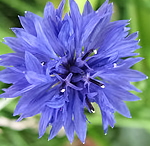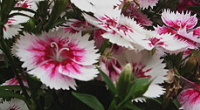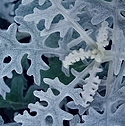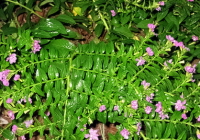More Easy Annual Flowers
written by Joseph Cash
Ageratum

It is easy to get the blues with ageratum, also called floss flower. The six inch tall plant has deep blue flowers most of the summer. It grows in sun to half shade and is not particular about soil but needs a fair amount of watering. You can start it from seeds or six packs. It also comes with white blooms.
Alyssum

Alyssum makes a four inch tall carpet of white or maroon blossoms good for the front of the flower bed. The plant, also called sweet alyssum, likes sun but will grow with half shade. It grows with a moderate amount of watering and can be started with seeds or six packs. Alyssum may need some trimming in late summer to keep blooming well.
Aster

Aster is a fall standout. Itís two or three feet tall stems have blooms of most every color. It can be grown from seeds planted in the spring or from potted plants available in spring and summer. Aster can take full sun or some light shade for half the day. Aster make good cut flowers. The plant needs to be planted in different location each year to avoid ďaster wiltĒ, a common disease.
Bachelorís Button
 Bachelor button is an old-fashioned favorite, is a long stem easy to grow annual. It grows 15 to 36 inches tall and comes in blue, red, white, pink and lavender varieties. Bachelorís Buttons, also called cornflower, likes a sunny location, an average soil thatís well-drained. Seeds can be planted in the spring or the previous fall. The long stems with blooms make good bouquets. Old blooms need to be removed to encourage new flowers.
Bachelor button is an old-fashioned favorite, is a long stem easy to grow annual. It grows 15 to 36 inches tall and comes in blue, red, white, pink and lavender varieties. Bachelorís Buttons, also called cornflower, likes a sunny location, an average soil thatís well-drained. Seeds can be planted in the spring or the previous fall. The long stems with blooms make good bouquets. Old blooms need to be removed to encourage new flowers.
Cosmos
 A sun loving annual for the back of the bed, cosmos grows from four to six feet tall. The plant has daisy-like blooms in shades of pink, rose, yellow, red, and purple, leaves are lacy. Cosmos likes full sun but will tolerate half a day of shade. Soil can be fair to poor for cosmos, and moderate to sparse watering is tolerable. The seeds can be started in the spring and the plants grow rapidly. If high winds can be expected in the garden, cosmos plants need staking to avoid being blown flat. Butterflies are attracted to cosmos.
A sun loving annual for the back of the bed, cosmos grows from four to six feet tall. The plant has daisy-like blooms in shades of pink, rose, yellow, red, and purple, leaves are lacy. Cosmos likes full sun but will tolerate half a day of shade. Soil can be fair to poor for cosmos, and moderate to sparse watering is tolerable. The seeds can be started in the spring and the plants grow rapidly. If high winds can be expected in the garden, cosmos plants need staking to avoid being blown flat. Butterflies are attracted to cosmos.
Dianthus
 Dianthus, also known as "sweet williams" and "pinks", are usually sold in garden centers with annuals, but are really short-lived perennials. It can return in some areas for two or three years. It can be a perennial in zones six and higher. Sweet Williams can be started from seeds, but they are usually started from six packs or small pots.
Dianthus, also known as "sweet williams" and "pinks", are usually sold in garden centers with annuals, but are really short-lived perennials. It can return in some areas for two or three years. It can be a perennial in zones six and higher. Sweet Williams can be started from seeds, but they are usually started from six packs or small pots.
A close relative of the florist's carnation, dianthus produces flowers that are white, pink, purple, red, and any combination. The plant grows close to ground, about four inches and sends up spikes up to 12 inches with a number of flowers on each spike.
Dianthus can be grown from seed, but is usually started from six packs or pots up to one gallon in size. It is planted near the front of the flower bed and grows best in fertile soil in partial shade to full sun up to six hours.
Space the plants about a foot apart. Give a light application or liquid fertilizer about once a month, and remove old flower stalks to encourage new blooms. Dianthus is a close relative to the florists favorite, carnation. Butterflies like dianthus as well.
Flowering will continue until frost kills the plant down to the roots. After a mild or average winter you may see dianthus return in spring.
Dusty Miller
 Dusty miller is grown not for its flowers but for its silvery gray foilage. Some varieties have finely divided leaves that add a lacey touch. The plant serves as a buffer between more brightly colored annuals that might clash if grown next to each other. They usually are not grown alone.
Dusty miller is grown not for its flowers but for its silvery gray foilage. Some varieties have finely divided leaves that add a lacey touch. The plant serves as a buffer between more brightly colored annuals that might clash if grown next to each other. They usually are not grown alone.
Dusty is slow to start from seeds and is usually purchased as six packs in the spring. The plant is about 15 inches tall and likes full sun with slightly dry soil.
Dusty will survive light freezes and on very rare occasions may survive a very mild winter though it almost always needs to be replanted.
Gebera Daisy

Gebera Daisy is a colorful daisy-like plant that can brighten any garden. The three inch wide blooms are red, pink, yellow, white, or orange.
Gebera grows about 14 inches tall, and is a perennial in zones 9 or higher. The flower stalks have single blooms and are used by florist in gift bouquets. The broad leaves are medium green. The can wilt readily when not enough water is available. The plant likes six hours of sun, preferably in the morning.
Mexican Heather
 Mexican Heather is a cool little plant. Growing only about a 12 inches tall and a little wider. Its charm is not its size but is graceful fern-like foliage which become studded with deep purple-blue flowers as they grow.
Mexican Heather is a cool little plant. Growing only about a 12 inches tall and a little wider. Its charm is not its size but is graceful fern-like foliage which become studded with deep purple-blue flowers as they grow.
Mexican heather will grow in half shade and is not picky about soil type.
The plant is purchased as a six pack or in small pots in the spring. It is used along the front border of the flower bed and in hanging pots that show off its graceful leaves. Mexican Heather can survive as a perennial in hardiness zones 8 or higher.
Nasturtium
Nasturtiums are an easy to grow annual that sprout easily from seeds sprouted in the spring. The plant does not transplant well. It grows from 10 to 15 inches tall and grows best in full sun to half shade.
Well drained soil works best for nasturtiums and they grow best slightly on the dry side since too much water can lead to few flowers. The blooms are mostly orange or yellow. Nasturtiums need little care and grow well on poor soil. The leaves can be eaten in salads.
Nicotiana
A close relative of the petunia, the Nicotiana is also known as the flowering tobacco. A plant with delicate trumpet-shape flowers, nicotania has a strong sweet scent. The flowers are red, lavender, pink, rose, or white and open mainly in the evening, though some varieties are day bloomers.
Seeds are extremely small and a little slow to start so they are usually purchased as small plants in the spring. Plant 14 inches apart in full sun with a little shade in very hot areas. Nicotiana can grow in almost type of soil and are slightly drought tolerant. The plants grow 1 to 3 feet tall, and are usually planted in the bed or in pots.
Sunflowers
Sunflowers are true sun worshipers. Not only do the foot wide flower heads resemble the sun with the golden petals on the rim looking like sun rays, but the entire heads point themselves at the sun through the day.
Despite their impressive size of up to 12 feet, sunflowers are easy to grow. The plant needs full sun, six hours or better, and prefer good soil. An inch or two of water a week and a little fertilizer will keep them reaching for the sky.
Sunflowers grow easily from seeds planted half an inch deep when danger of frost is over in the spring. Plant a couple of them every foot. When six inches tall, thin to one every 24 inches. Rake soil around each stem to help support its rapidly grow stature. Once they are four feet tall, they may need the additional support of stakes to keep them from blowing over in windy areas.
After the seed heads develop at the top of the stem, it grows into a wide disk. The top of the plant will droop as the head gets heavier. The seeds develop on the top of the disk. Sunflower seeds are grown commercially in America and Australia, they make a great snack roasted. The oil in the seeds is used in many foods, and many pet birds as well as wild ones are fed sunflower seeds.
Children love growing sunflowers because of their great size and tasty seeds.
|



 Bachelor button is an old-fashioned favorite, is a long stem easy to grow annual. It grows 15 to 36 inches tall and comes in blue, red, white, pink and lavender varieties. Bachelorís Buttons, also called cornflower, likes a sunny location, an average soil thatís well-drained. Seeds can be planted in the spring or the previous fall. The long stems with blooms make good bouquets. Old blooms need to be removed to encourage new flowers.
Bachelor button is an old-fashioned favorite, is a long stem easy to grow annual. It grows 15 to 36 inches tall and comes in blue, red, white, pink and lavender varieties. Bachelorís Buttons, also called cornflower, likes a sunny location, an average soil thatís well-drained. Seeds can be planted in the spring or the previous fall. The long stems with blooms make good bouquets. Old blooms need to be removed to encourage new flowers.
 Dianthus, also known as "sweet williams" and "pinks", are usually sold in garden centers with annuals, but are really short-lived perennials. It can return in some areas for two or three years. It can be a perennial in
Dianthus, also known as "sweet williams" and "pinks", are usually sold in garden centers with annuals, but are really short-lived perennials. It can return in some areas for two or three years. It can be a perennial in  Dusty miller is grown not for its flowers but for its silvery gray foilage. Some varieties have finely divided leaves that add a lacey touch. The plant serves as a buffer between more brightly colored annuals that might clash if grown next to each other. They usually are not grown alone.
Dusty miller is grown not for its flowers but for its silvery gray foilage. Some varieties have finely divided leaves that add a lacey touch. The plant serves as a buffer between more brightly colored annuals that might clash if grown next to each other. They usually are not grown alone.
 Mexican Heather is a cool little plant. Growing only about a 12 inches tall and a little wider. Its charm is not its size but is graceful fern-like foliage which become studded with deep purple-blue flowers as they grow.
Mexican Heather is a cool little plant. Growing only about a 12 inches tall and a little wider. Its charm is not its size but is graceful fern-like foliage which become studded with deep purple-blue flowers as they grow.